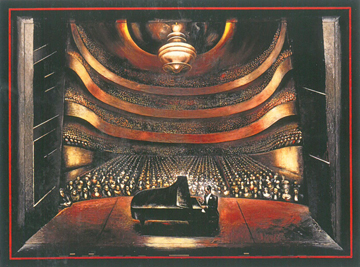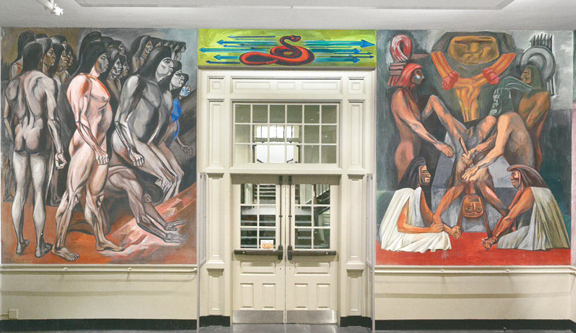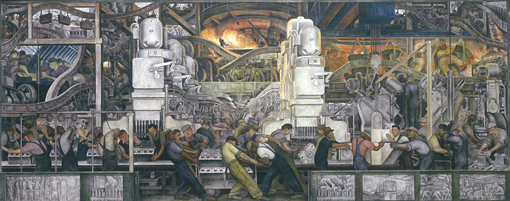Art Review: Reality: TV or the Mexican Muralists?
By Jean Bundy
arttimesjournal February 8, 2017
 David Siqueiros' George Gershwin in a Concert Hall 1936; |
Most people have had one television in their homes for decades. In the fifties, TV was a fuzzy black/white picture that needed constant adjusting with “rabbit ears,” producing an image that rolled and fizzled, slightly out of focus and often frightening to watch. Broderick Crawford’s Highway Patrol showed viewers that right and wrong were easy to detect, a metaphor for the US having won World War II. I Love Lucy’s skit about wrapping chocolates on a conveyer belt that gradually sped up as Lucille Ball tried to beat the system, proved that housewives were made for more than parading in shirtwaists and heels as they awaited homecoming husbands. However, Ball was still doing manual labor as opposed to presiding in a boardroom. And Donna Reed of her namesake sitcom continues to epitomize the “Betty Crocker” perfect housewife who smiled as she vacuumed sweat-free. Always cheerful, she could make her husband believe he was king, even when his oppressive boss threatened “you’re fired” at the slightest whim. By the Sixties, with the Vietnam War strangling us, we would learn that right and wrong were not so easy to assimilate.
Even kids’ shows like Howdy Doody not only insisted on a right and wrong theme but were also scary to kids plopped in front of this new babysitter, unfiltered. But cracks were forming in the right/wrong television formats of the post-World War II era as even shows like Leave it to Beaver revealed Ken Osmond’s “Eddie Haskell” could be a bully with unctuous charisma, yet often won. Sesame Street and Mister Rogers’ Neighborhood revolutionized how children looked at TV by calmly suggesting that nothing is in fact black and white. These shows also promoted the idea that “Wonder Bread Caucasians” shouldn’t be who network television solely addressed. As media blended, artists like Rauschenberg and Warhol used television imagery to highlight the importance of this new technology for delivering the complexities of reality.
Becoming de-sensitized to violence in films like Pulp Fiction got easier, while the media dug in their heels when asked to tone down blood and gore. Has being de-sensitized gone too far? Noticing squirming toddlers in multiplexes, watching what would have been considered hard-core porn in yesteryear, has become a common sight. Back in the sixties, when friends and I went to see matinees in the Times Square of pimps and prostitutes, we were ushered into cabs like celebrities, so not to be tainted by the sleaze. Today, the Vietnam era continues to shadow us and what is egalitarian remains a de-sensitization.
 Jose Orozco's The Epic of American Civilization, 1932-1934 |
This brings me to the phenomenon of Reality TV which allegedly elevates “joe-average” into actors who appear on camera to eat bugs, hang from tires or go on corporate quests for a “Warhol’s fifteen minutes of fame.” But is this really, reality? Only a few make it to stardom while viewers enjoy hubris on a massive scale. But in reality, it is the network executives that financially succeed, having created the myth that any “Tom, Dick or Harry” can achieve celebrity status, which gets me to the Mexican Muralists.
The exhibition, Paint the Revolution: Mexican Modernism, 1910-1950, shown last fall at the Philadelphia Art Museum, implied that art effects changes to our society. From a Formalist standpoint, these works are beautiful as many of the artists attained European training or studied in early twentieth century Mexican ateliers, associated with revolutionary reconstruction. Murals mixed Indian culture with Spanish Colonialism as they adorned governmental walls with a feeling of Reality TV, portraying the supposed realities of a modern Mexico. Like their socialist European counterparts, the artists had a pretext of being anti-bourgeois.
While some Mexican artists spoke to social injustice, the bureaucratic institutions displayed themes about innovative farming and new technologies: railroads, the oil industry and telecommunication. In reality, the welfare of the average peasant did not improve with this aesthetic propaganda, just like the era’s peasant populations in Europe. And similar to Reality TV, these murals did not address realities of crime and poverty. Success for the famed muralists Rivera, Orozco and Siqueiros increased when they were lured to the United States. The Great Depression created radical organizations like John Reed Clubs, while Roosevelt’s administration subsidized starving artists. Greatly influenced by Modernism, Mexican artists like Rivera studied in Europe. Alfred Barr met Rivera in Moscow and organized a MoMA exhibition for him. Once in America, Orozco, Siqueiros and Rivera, The Three Amigos, were grabbed up by corporations and universities, thus embedding themselves into a capitalist system with its opportunities to hobnob for greater commissions while becoming bourgeois themselves.
 Diego Rivera's Detroit Industry, 1932-1933 |
Memorable at 30Rock, was the destruction of Man at the Crossroads, as ordered by John D. Rockefeller Jr. because Rivera refused to erase Lenin, who glorified laborers—guys who made scions like Rockefeller rich. Displaying imagery of the worker at Rockefeller Center, one of the most iconic monuments to American industrialists, bears similarity to substituting wealthy celebrities on Reality TV for contestants who want a chance to make it rich too. The mass appeal of television has blurred so many boundaries that today we might accept a Lenin-esque figure surrounded by capitalist tropes. After all, we laugh at satirizing Putin on Saturday Night Live, a product of blue-chip NBC which ironically broadcasts from 30Rock. So, is the spectacle of using “joe average” on Reality TV a ruse for making a few executives rich? And when murals were originally painted did the artists empathize with the downtrodden or merely see a trendy opportunity for lucrative success?
Aesthetically, Mexican muralists innovatively combined the palette of Central America: oranges, reds, turquoises and earth tones, with Modernism’s flat, stackable shapes. They copied European red/ black propaganda posters, black/brown woodcuts and embedded Surrealism learned from Continental artists who sought asylum in Mexico. As viewers today, do we feel the anguish of past oppressions in these murals, or are we so de-sensitized we only see these works as well executed art?
In reality, murals are all we visually have remaining of what it was like to be a nineteenth century Mexican farmer, welder or peasant displaying wares. Muralists like Reality TV script writers were story tellers revealing the homogenized essence of a society. Mexican murals and Reality TV become simulacra as they both promote the real that wasn’t real.
But what is/was real? The workers in these murals are “spit and polished” as they patriotically support laboring or revolting. The new TV personalities do not necessarily represent the man on the street. Television, like Mexican murals, inverts reality, so we no longer understand reality. Maybe reality doesn’t matter anyway? Reality TV is about a chance at catching that brass ring. Mexican murals tell about the human desire for decency. In the end Reality TV like Mexican Murals will end up as research material.
Rivera’s Detroit Industry is at the Detroit Institute of the Arts; Orozco’s Epic of American Civilization surrounds Baker Library, Dartmouth; and Siqueiros’ George Gershwin in a Concert Hall is at Harry Ransom Center, University of Texas, Austin. The exhibition catalogue: Paint the Revolution, Mexican Modernism 1910-1950 is available on Amazon.
(Jean Bundy AICA-USA (Email: 38144@alaska.net) lives in Alaska.
